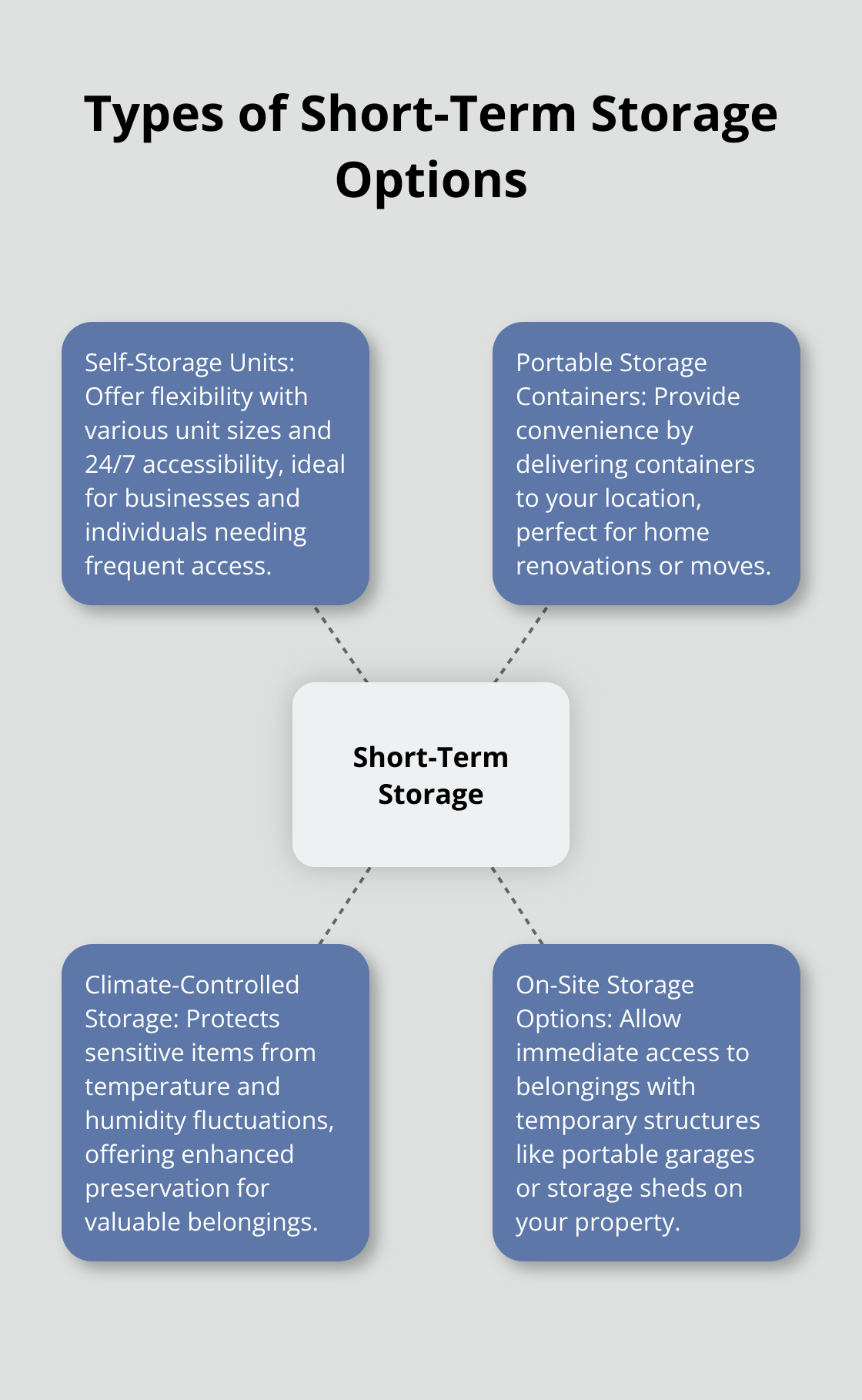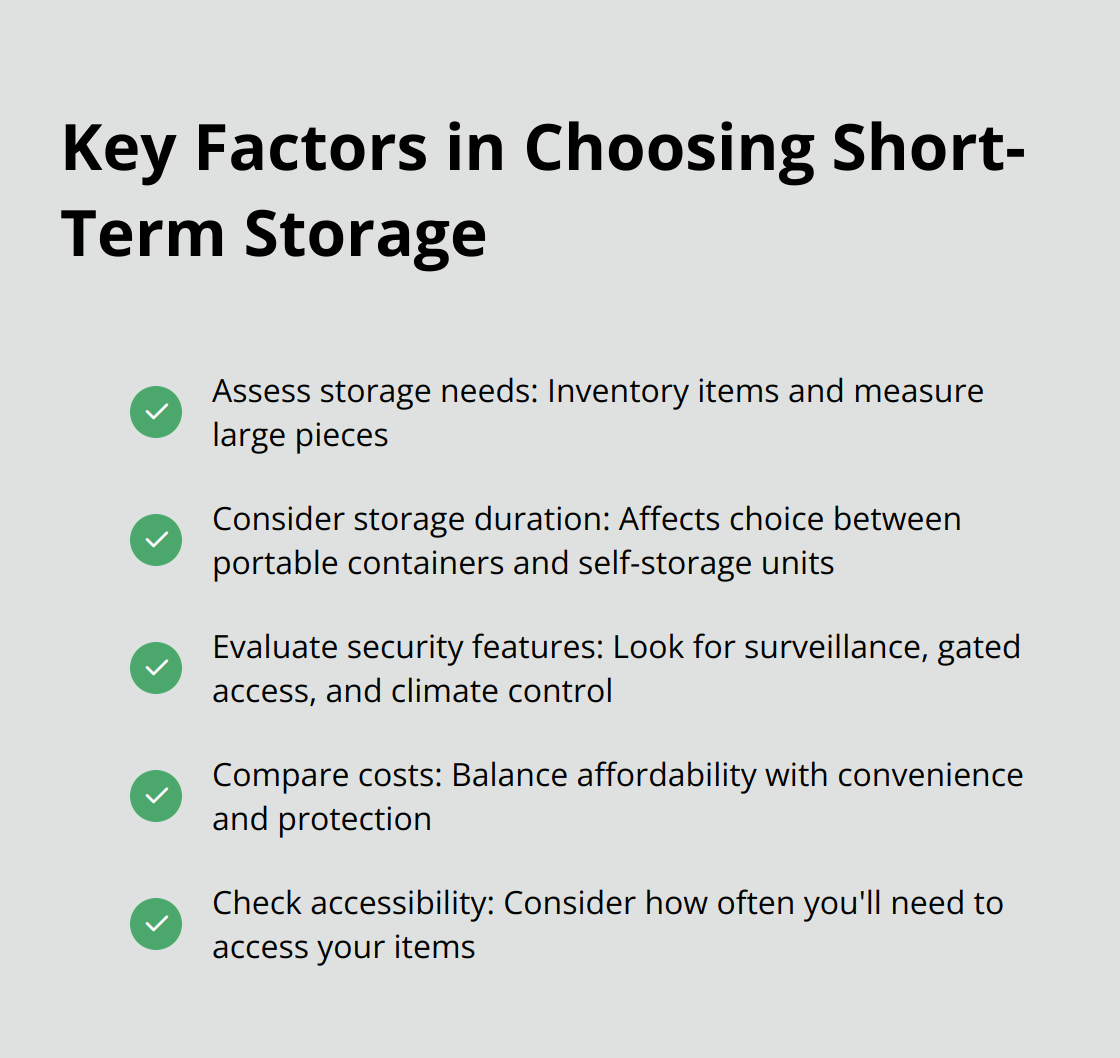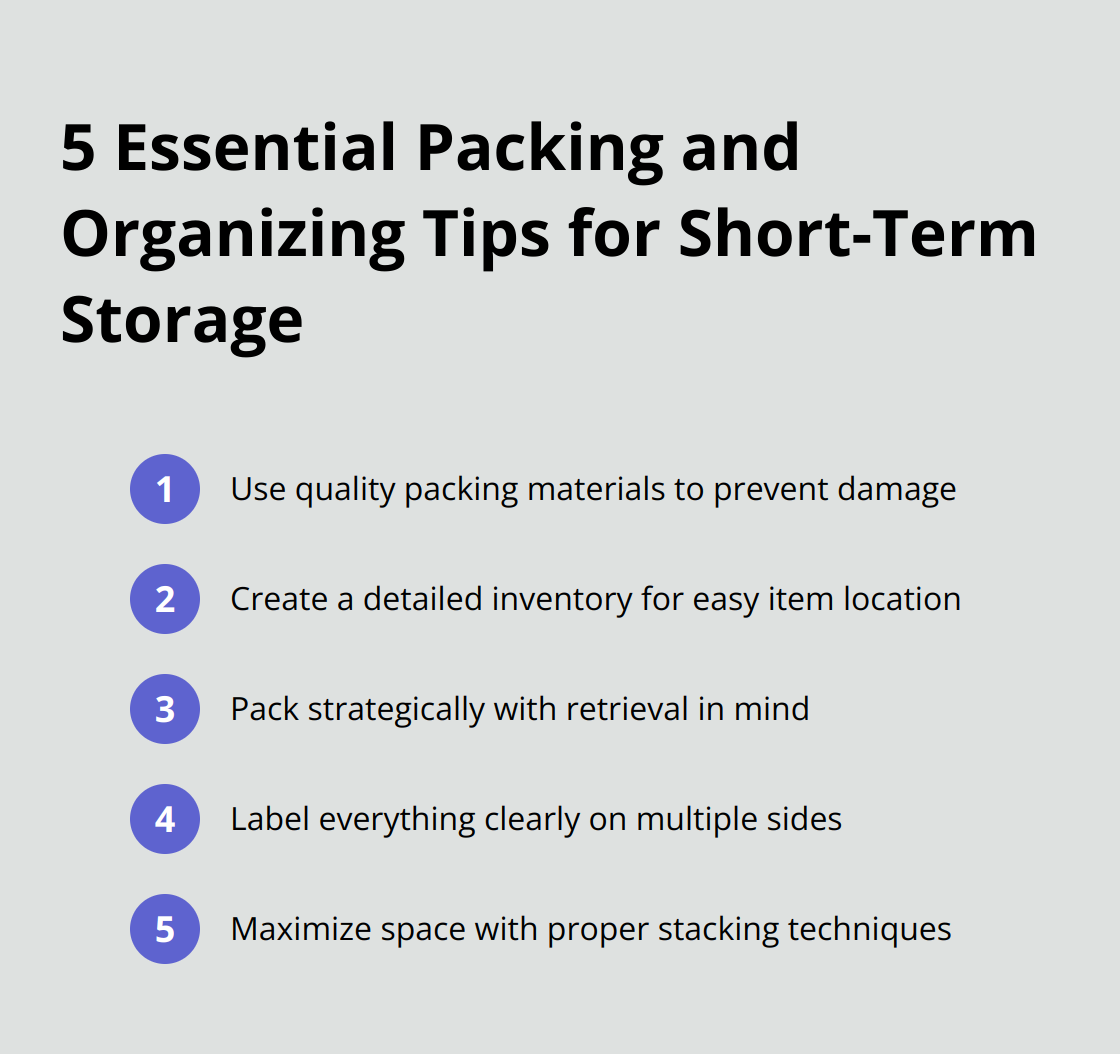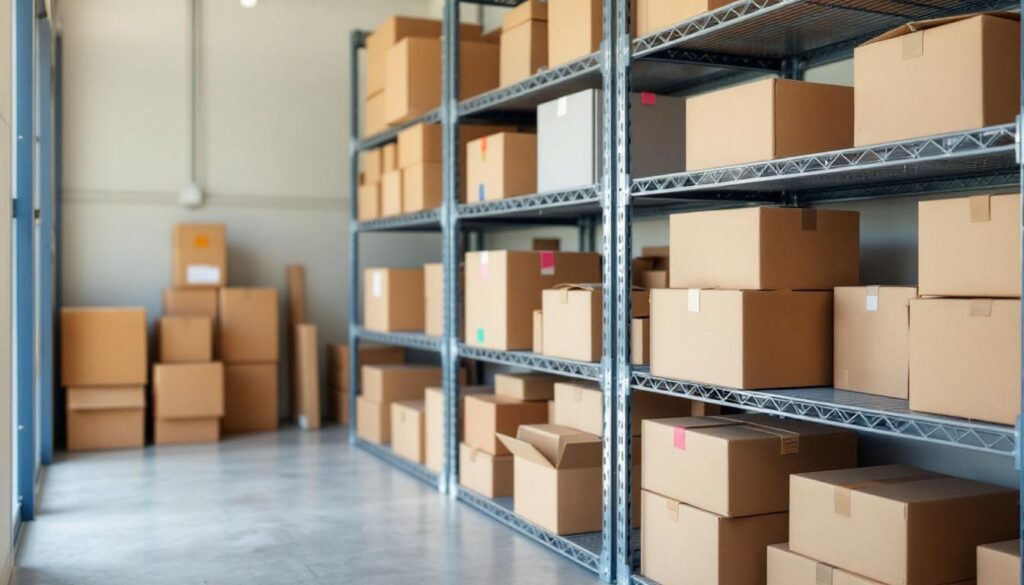Short-term storage facilities offer a lifeline when you need temporary space for your belongings. Whether you’re moving, renovating, or simply decluttering, understanding your options is key.
At Southbay Moving Systems, we’ve helped countless clients navigate the world of short-term storage solutions. In this guide, we’ll break down the types of storage available, how to choose the right option, and tips for efficient packing and organization.
What Are Your Short-Term Storage Options?
Short-term storage solutions offer various choices to meet different needs and situations. This chapter explores the most common types of short-term storage available.

Self-Storage Units: Flexibility and Accessibility
Self-storage units provide a popular option for temporary storage needs. These facilities offer unit sizes from 5×5 to 10×30 feet, with month-to-month rental options for maximum flexibility. The main advantage of self-storage units lies in their accessibility. Many facilities provide 24/7 access, which allows you to retrieve or store items whenever you need. This feature makes them ideal for businesses that require frequent access to inventory or individuals who store items they use regularly.
Portable Storage Containers: Convenience at Your Doorstep
Portable storage containers bring storage directly to your location. Companies deliver these containers to your home or business, where you can load them at your own pace. Once filled, you can keep the container on-site or have it transported to a secure storage facility.
This option proves particularly useful during home renovations or moves. You can pack your belongings directly into the container, which eliminates the need for multiple trips to a storage facility. However, portable storage containers often cost more than traditional self-storage units.
Climate-Controlled Storage: Protection for Sensitive Items
For items sensitive to temperature and humidity fluctuations, climate-controlled storage offers the best solution. These facilities provide protection from extreme weather, enhanced air quality, a barrier against dust, debris, and pests, humidity control, and preservation of stored items.
While climate-controlled units cost more than standard units, they provide peace of mind for valuable or sentimental items. The extra cost often justifies itself when you consider the protection it offers against extreme weather conditions.
On-Site Storage Options: Immediate Access
On-site storage options provide immediate access to your belongings. These can include temporary structures like portable garages or storage sheds placed on your property. This option works well for short-term projects or situations where you need frequent access to your items.
On-site storage eliminates the need for transportation to and from a storage facility. However, it may not offer the same level of security as dedicated storage facilities, and local regulations might restrict the use of certain temporary structures.
As we move forward to discuss how to choose the right short-term storage option, consider these various solutions and how they might fit your specific needs. The next section will guide you through the decision-making process to ensure you select the most suitable storage option for your situation.
How to Pick the Perfect Short-Term Storage Solution
Assess Your Storage Needs
The first step in selecting the right short-term storage option is to take inventory of what you plan to store. Measure large items and estimate the number of boxes you’ll need. A 5×10 unit can typically hold the contents of a mid-sized bedroom (including a queen-sized bed and several boxes). For a 2-bedroom apartment, a 10×10 unit, which offers about 100 square feet of space, might suffice.
Consider any unique items that require special care. Do you have a piano? Or perhaps business inventory that you need to access frequently? These factors will influence your choice of storage solution.
Consider the Duration of Storage
The length of time you need storage plays a significant role in your decision. For projects lasting less than three months, portable storage containers might be your best option. They offer convenience for short-term needs like home renovations or quick moves.
For longer periods, traditional self-storage units often provide the most cost-effective solution. Many facilities offer month-to-month rentals, which gives you flexibility if your plans change. If you’re uncertain about the duration, choose a facility that doesn’t require long-term commitments.

Evaluate Security Features
Security should top your list of priorities when choosing a storage solution. Look for facilities with robust security measures such as 24/7 video surveillance, gated access, and on-site management. A report by the Self-Storage Association indicates that facilities with these features have significantly lower rates of theft and property damage.
Climate control is another important security feature, especially if you’re storing valuable or sensitive items. These units protect from extreme temperatures, control humidity, preserve fragile items, and offer enhanced security.
Compare Costs and Accessibility
Finally, consider your budget and how often you’ll need to access your items. Self-storage units are generally the most affordable option, with prices ranging from $35 to $100 per month for standard units. However, if you need frequent access, the cost of travel to and from the facility might offset these savings.
Portable storage containers, while more expensive, offer unparalleled convenience. They’re delivered to your doorstep, which eliminates the need for multiple trips to a storage facility. This can make a significant difference if you’re in the middle of a hectic move or renovation.
The cheapest option isn’t always the best. Factor in the value of your time and the importance of your stored items when making your decision. Choosing the right storage solution can significantly reduce stress and streamline the moving process.
Now that you understand how to choose the right short-term storage option, let’s move on to the next critical step: packing and organizing your belongings for storage. Proper packing techniques can maximize your storage space and ensure your items remain in excellent condition throughout their stay.
How to Pack and Organize for Short-Term Storage
Invest in Quality Packing Materials
Don’t skimp on packing materials. Cheap boxes can collapse under weight, and flimsy tape can come undone. Use sturdy boxes, packing tape, bubble wrap, and packing paper. For fragile items, use specialized materials like dish pack boxes or wardrobe boxes.
Quality packing materials prevent damage and preserve the condition of your belongings during transportation or storage.
Create a Detailed Inventory
Before you pack, create a detailed inventory of everything you plan to store. This step might seem time-consuming, but it proves invaluable when you need to locate specific items later.
Use a spreadsheet or inventory app to list each item and its corresponding box. Assign each box a unique number or code. This system will save you time and frustration later (especially if you’re storing business inventory or important documents).
Effective inventory control balances controlling costs and meeting customer demands.

Pack Strategically
Pack with retrieval in mind. Place items you might need to access frequently near the front of your unit. Use clear plastic bins for these items so you can see the contents easily.
For boxes, pack heavier items at the bottom and lighter ones on top. Fill empty spaces in boxes with packing paper to prevent shifting during transport.
Disassemble furniture when possible to save space. Wrap each piece individually and keep all hardware together in a labeled bag.
Label Everything Clearly
Clear labeling is essential for efficient storage. Label each box on multiple sides with its contents and the room it belongs to. If you’re using a numbering system, include the box number as well.
For added organization, consider color-coding your labels by room or category. This visual system can make locating items much quicker.
The more detailed your labeling, the less time you’ll spend searching for items later (which can be a significant time-saver during a stressful move or renovation).
Maximize Space with Proper Stacking
Try to maximize your storage space through proper stacking techniques. Place heavier boxes at the bottom and lighter ones on top. Create stable stacks by aligning box corners.
Leave small walkways between stacks to access items easily. Use vertical space efficiently by stacking boxes to the unit’s ceiling (if safe to do so).
For oddly shaped items, consider using sturdy shelving units to create additional storage levels within your unit.
Final Thoughts
Short-term storage solutions provide various options to meet different needs. Self-storage units, portable containers, climate-controlled facilities, and on-site options each cater to specific requirements. The right choice depends on your needs, storage duration, security features, costs, and accessibility.
Proper planning and organization maximize the benefits of your chosen storage solution. Quality packing materials, detailed inventories, and clear labeling save time and reduce stress during the storage process. Strategic packing and efficient space use ensure your belongings remain accessible and protected.
Professional moving and storage services offer significant advantages for many people. Southbay Moving Systems can help streamline your short-term storage needs with our experience and 20,000 sq. ft. storage facility. A short-term storage facility provides the flexibility and convenience you need for renovations, moves, or extra space requirements.




